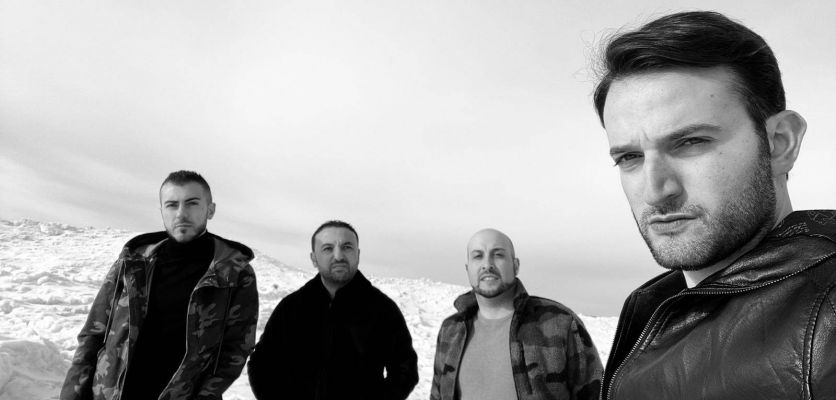'My Artsakh': How a group of Canadian-Armenian vocalists created an unforgettable mash-up
Sevag Haroutunian, Nver Ghazaryan, Levon Karagulian, and Toros Maydossian
June 16, 2020
Chances are you’ve all heard the songs—classics and more recent ballads (six in all) dedicated to Artsakh, its history, its natural beauty, its people, and its heroes... But you’ve probably never heard them as a part of a mash-up! Read all about “My Artsakh” in this h-pem exclusive!
| Genre | Mash-up |
| Location | Toronto, Canada; Yerevan, Armenia |
| Language | Armenian |
| Duration | 5:37 |
| Link |
The music video to “My Artsakh” opens with four young men traversing the snow-clad fields of Georgian Bay, Ontario, Canada, and breaking into song. The scenes constantly cut between the winter landscape and beautifully-shot images of the Republic of Artsakh, featuring its picturesque mountains.
If Sevag Haroutunian—one of the four Toronto-based Armenian singers (and, full disclosure, a childhood best friend!) who collaborated on the project—had not confessed that the singing scenes were shot in Canada, they probably would have had you fooled, too.
.png)
“Artsakh’s landscape is breathtaking, and there was no question that those shots needed to be in there. Not shooting in the natural beauty of the outdoors and resorting to filming inside a studio [with a greenscreen] would cheapen the experience,” he explained during a recent conversation. “Canada’s winters are beautiful, so, since we couldn’t be in Artsakh, we decided to include both without specifying which is where,” Sevag went on. The music video also features four dancers from Toronto’s Hamazkayin Erebuni Dance Ensemble. “Their part was immensely important to give it the traditional flavor and jolt of energy; to keep the audience captivated throughout,” Sevag said.
Haroutunian, who was born and raised in Toronto and took his first musical steps within the A.R.S. Armenian School and the city's Armenian community, came up with the sharan (a series of songs; or a series in general terms) back in 2018. “These days, especially with modern music, folks call it a mash-up. But sharans have existed in Armenian music for years,” he explained, before detailing the process of blending songs together.
The popularity of mash-ups in Armenian pop music has certainly grown in recent years, with many artists even mixing well-known non-Armenian melodies with Armenian favorites (check out the “Armenian Mashup” series by David Greg, Diana Barseghyan, and Izabella Asmaryan).
The mash-up concept has definitely evolved over the years. These days, small snippets from each song are mixed in and out, with some jumping back and forth between them. When it came to working on a mash-up of his own, Sevag decided that, instead of adopting random songs that aren’t necessarily connected with one another, he could choose a central theme—one that would speak to the heart of all Armenians, both in the homeland and throughout the diaspora. “Our music is so rich. There are so many notable songs celebrating Artsakh. These certain songs harmoniously came together on the same tempo, the same key. They came to life together,” Sevag said.
.png) On set of the "My Artsakh" video shoot. L-R: Toros Maydossian, Nver Ghazaryan, Sevag Haroutunian, and Levon Karagulian (Photo courtesy of Sevag Haroutunian)
On set of the "My Artsakh" video shoot. L-R: Toros Maydossian, Nver Ghazaryan, Sevag Haroutunian, and Levon Karagulian (Photo courtesy of Sevag Haroutunian)
The six songs are a good mix of old and new: classics and not-so-classic hits that beautifully describe the uniqueness of Artsakh. “Karabakh” (Seto Baghdassarian); “Artsakh” (lyrics: Vahan Andreasyan; music: Arthur Grigoryan); “Karabakh Im” (lyrics: Aramayis Sahakyan; music: Armen Mandakunyan); “Arjani” (Edmond Makaryan); “Karmir Kakachner” (Ruben Havkerdyan); and “Yelek Hayer” (popular) all come together seamlessly, in perfect harmony.
Joining Sevag on the project were Nver Ghazaryan, Levon Karagulian, and Toros Maydossian—close friends and fellow members of the Hamazkayin Kousan Choir of Toronto. The foursome has been collaborating on various Armenian songs over the past few months, with the mission to “feature our cultural treasures with a choral/harmonic rendition—something, which can be more relatable to others in our age group and Armenian Diasporan youth in general,” as Sevag explained. Together, the group has performed in the Toronto Armenian community on a number of occasions, including a fundraiser for the Tufenkian Foundation’s activities in Artsakh (2018), the Hayastan All-Armenian Fund's Toronto Gala (2019), and the Hamazkayin Toronto Klatsor chapter's “Anmorats Yerger” ("Unforgettable Songs") concert (2019).
Though “My Artsakh”’s vocals were recorded in Toronto, the song was actually produced in Armenia. “The music was placed in sequence and rehearsed by us, one by one, to assure we can all work in the same key,” said Sevag. The song was then sent to Armenia, so the music could be arranged, and the progression of the instruments could be composed. “It’s a back-and-forth process, which slows things down. And the chemistry is harder to maintain when working from abroad and translating an idea into notations for instruments over Facetime,” Sevag explained.
Fortunately for them, the group worked with some of the cream-of-the-crop in the Armenian music scene. After looking into the work of several different producers in different parts of the world, they zeroed in on Garegin Arakelyan (of Gata Band). “Gata was our best bet to ensure that Armenian flavors in the melody were preserved and that the songs got the attention they deserved. Keep in mind, it’s not a short track [about five and a half minutes of music], so it’s not easy to maintain the power throughout,” Sevag said.
Besides his inimitable, distinct vocal touches, Arakelyan is one of those musicians who seems like he can master any instrument he picks up. The santoor, pku, a wide range of percussion instruments, and his signature Kelstone are only some of the many he so expertly plays.
“He [Garegin] is always experimenting and pushing boundaries to make a track unique and modern. But he’s also adamant on the music staying true to its roots and feeling authentic. He’s got an excellent sense of balance in this music, and I believe we achieved this with our track,” Sevag mentioned. “There are parts in the mash-up when you hear the soft tunes of the kamancha—almost like a flowing stream. Then, it builds up to the intensity of the dhol and pku. I think he pulls it off almost perfectly.”
Each of the four singers brings his own unique style to the group: all have different timbres and ranges, which added to the richness of the final product. “Together, we make up the full range—like the different colors on a palette coming together to bring a painting to life,” described Sevag.
Each of the four also has a different level of experience and training, which, according to Sevag, adds to the authenticity of the track, which was released on the 28th anniversary of the liberation of Shushi. “Some of us have vocal training: some have musical solfege training, others have classical theory training. We are fortunate enough to have professional friends, from whom we seek advice. There were constant dialogue and consultations going on behind the scenes,” Sevag explained.
.png) A still from the "My Artsakh" music video. L-R Toros Maydossian, Levon Karagulian, Nver Ghazaryan, and Sevag Haroutunian. (Image courtesy of Sevag Haroutunian)
A still from the "My Artsakh" music video. L-R Toros Maydossian, Levon Karagulian, Nver Ghazaryan, and Sevag Haroutunian. (Image courtesy of Sevag Haroutunian)Sevag, Nver, Levon, and Toros have also made it a point that they are not a stand-alone quartet—they are open to performing with different singers and musicians (some of the aforementioned performances were done with other young Armenian singers and musicians based in Toronto). That is part of the reason the four have decided not to formally name the group. “We have thought about coming up with a name, but given our fluidity, it’s not a priority. We don’t want to lose that flexibility,” he explained. “We do this for the love and passion for music,” he explained, adding that the four are open to collaborate with anyone who wants to work with them and who connects to them musically.
When asked about what the future holds for the four vocalists, Sevag said that, given the success of this song and the outpouring of support they have received, they will consider exploring and creating similar mash-ups in the near future. Their next project, Sevag promised, will also feature a female vocalist with a completely different vocal timbre.
The “My Artsakh” project is evidence that there is a real interest in making quality Armenian music in the Armenian Diaspora and that working hand-in-hand with professionals in Armenia can yield some amazing results. Besides the four vocalists, two fellow Toronto-Armenians worked on making the song and its video a reality: Chant Sleiman worked on recording and harmonizing the track’s vocals, while director of photography Areg Haroutunian and his team filmed, directed, and produced the music video.
“It's amazing that there are so many young Armenians born and raised in the diaspora that are so into Armenian music—that we are able to express ourselves in our mother tongue and to create and make music with such talented people right here, in North America,” Sevag explained. “This is just another way we can show that Armenian youth in the diaspora are immersed in their culture and that our adopted countries only add flavor when we create and re-create our traditional melodies.”
If you enjoyed "My Artsakh," you'll love the vocalists' renditions of Komitas' "Horovel" and Gusan Ashot's "Sari Sirun Yar."
Join our quest to keep up with the trends!
Video
Join our community and receive regular updates!
Join now!






Liza Manoyan
20 Sep, 2020 16:58:27 Edited
Thanks Roupen a lot for highlighting this band and introducing them to us. I have never heard about them.
0
Reply